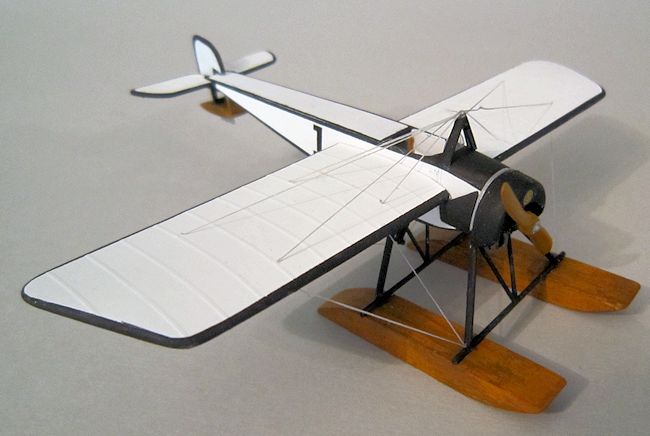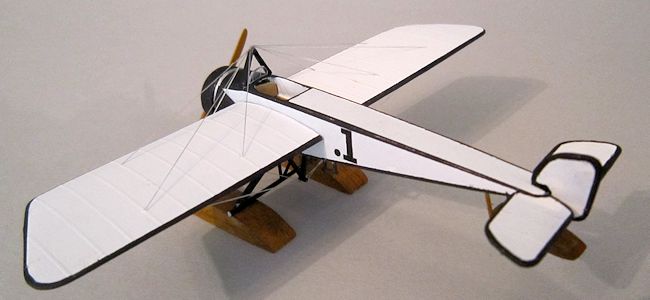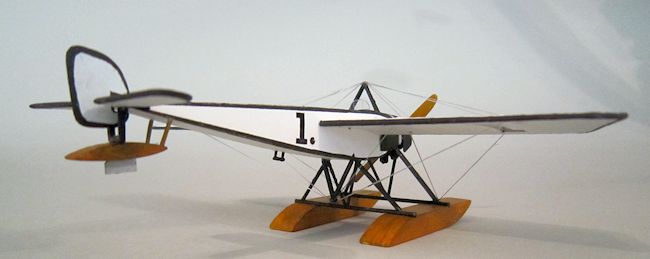
AZ Models 1/72 Morane-Saulnier type WR
| KIT #: | AZ 7376 |
| PRICE: | About £10 here in the UK, or approx $20 |
| DECALS: | Three options |
| REVIEWER: | Chris Peachment |
| NOTES: | Short Run |

| HISTORY |
The WR follows Morane Saulnier's great family of pre-WWI monoplanes in having a
boxy fuselage and shoulder mounted wings employing wing warping for lateral
control. Jules Vedrines won the Paris-Madrid race in May, 1911 in one.
 Their first commercially successful design was the G which was very successful
in racing, and setting records. The WR was a variant of this using floats and a
more powerful engine for the Schneider Trophy races.
Of
course after WWI the Schneider Trophy continued, leading up to the final
victories by the Supermarine S.6B, which was the progenitor of the Spitfire and
the rest is history.
Their first commercially successful design was the G which was very successful
in racing, and setting records. The WR was a variant of this using floats and a
more powerful engine for the Schneider Trophy races.
Of
course after WWI the Schneider Trophy continued, leading up to the final
victories by the Supermarine S.6B, which was the progenitor of the Spitfire and
the rest is history.
So
what you have here is the grandaddy, the fons et origo, the first
faltering step in the long march towards the aircraft which won the Battle of
Britain and saved the free world.
It is sobering to re-read that last sentence and realise that the final part is no exaggeration. (I think that perhaps you'd get some discussion on that from those who don't live in the UK. ;) Ed)
| THE KIT |
The kit is typical of AZ models now. They are
short run, with no locating lugs. I have come to prefer this kind of
construction, since it makes alignment much easier. In fact I frequently remove
lugs from other kits, when it becomes clear that they are preventing good
alignment. The mouldings are good, with minimal flash and only the usual seams
to remove. And the fit of parts is also very good.
Some short run kits have become
nearly as good
as conventional ones.
 The kit comes with
wheels and conventional undercarriage and also struts and floats in polyurethane
for the WR version.
The kit comes with
wheels and conventional undercarriage and also struts and floats in polyurethane
for the WR version.
There are three decal options including the one below as flown by Roland Garros
at the 1914 Schneider trophy, which was unplaced. Secondly, No 2, which the box
art proclaims was flown by Lord John Carbery.
Although some records state that he flew in a Deperdussin and was also
unplaced. The evidence seems to vary. He may well have practised in the Morane.
The winner in 1914 was the British Sopwith Tabloid and
most of the competitors withdrew when they saw how fast it was.
The
third option, a Morane Saulnier type 3G (Thulin B), from 1915 of the Swedish Air
Force. These last two were finished in clear doped linen. The Roland Garros
aircraft was in white.
| CONSTRUCTION |
I used the standard cockpit, and for once
with a short run kit, it fit very well, with no need to trim the floor width.
There is a nice bucket seat, control column, rudder bar and primitive panel with
one instrument on it, which I would guess would be an airspeed indicator. Since
the Schneider trophy race was over a low level course in clear weather around
markers, there would be no need for any others.
 The interior was sprayed white, with some
wood detailing on the frames and a wood panel, aluminium stick and rudder bar.
All the pieces go together with no trouble at all, and there is nothing to take
extra care over. The fuselage needed a little sanding on the seams but no
filler. The wings need to be shortened by cutting off one rib's width inboard,
which is in the instructions. Only the Thulin B had full span wings.
The interior was sprayed white, with some
wood detailing on the frames and a wood panel, aluminium stick and rudder bar.
All the pieces go together with no trouble at all, and there is nothing to take
extra care over. The fuselage needed a little sanding on the seams but no
filler. The wings need to be shortened by cutting off one rib's width inboard,
which is in the instructions. Only the Thulin B had full span wings.
Wings fuselage and tailplane were sprayed
white separately, and then the long business of masking off the edging all the
way round, and painting them black. Well worth doing however, and the finished
paint scheme is cool and elegant. Remember the horse racing
scene at Ascot in My Fair Lady? That too was costumed all in black and
white.
Engine cowl and forward fuselage were also
black, although the edge of the firewall needs to be silver, as in the pictures.
Struts too are black and it is worth doing them at this stage after removing
seams.

| PAINTING AND THE REST |
Final construction nd support to set. The engine is black, dry brushed with gunmetal.
When fitting the cowl, there is always the possibility of spreading glue over
the pre-painted mounts and so I used Humbril Clearfix for this. Any PVA glue
would do. If you make a mess then you can rub it off and it won't scar the
plastic.
nd support to set. The engine is black, dry brushed with gunmetal.
When fitting the cowl, there is always the possibility of spreading glue over
the pre-painted mounts and so I used Humbril Clearfix for this. Any PVA glue
would do. If you make a mess then you can rub it off and it won't scar the
plastic.
Rigging is straightforward and there is a
good diagram in the instructions. I used my usual method of elastic mending
thread, coloured silver, and held in place with small drops of superglue gel,
applied with a toothpick. The gel can be placed much more precisely than
ordinary superglue which is malicious stuff, runs all over the place and then
attacks your fingers, as mentioned above.
The rear float needs a rudder, which is thin plastic card painted silver. The kit provides no windscreen, so I made one from the huge pile of discarded plastic packaging which I keep in one corner of the study. I have enough there to re-create the old Phantom Mustang of Monogram renown. The prop is wood, with clear orange on top, a silver hub. Finally there is a neat yellow MS logo for the cowl front which sets it all off to a T.
| CONCLUSIONS |
It only took a day's modelling and you have a
nice little replica of an important pre-WWI racer. And a good tribute to the
great Roland Garros who went on to distinguish himself as a French ace in WWI.
And incidentally, was the first to use a machine gun firing through the
propeller, in a Morane.
| REFERENCES |
http://bayourenaissanceman.blogspot.co.uk/2011/02/100-years-of-airplanes.html
http://www.theaerodrome.com/forum/camouflage-markings/40690-morane-soulnier-g.html
http://www.ctie.monash.edu.au/hargrave/morane-saulnier.html
http://flyingmachines.ru/Site2/Crafts/Craft25737.htm
July 2014 If you would like your product reviewed fairly and fairly quickly, please
contact
the editor or see other details in the
Note to
Contributors.